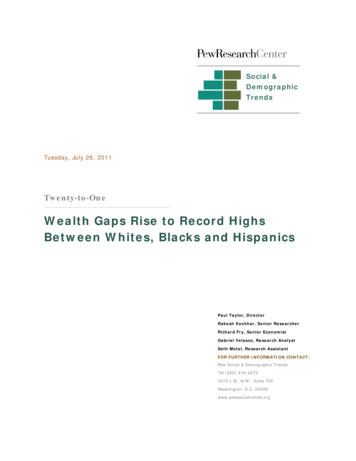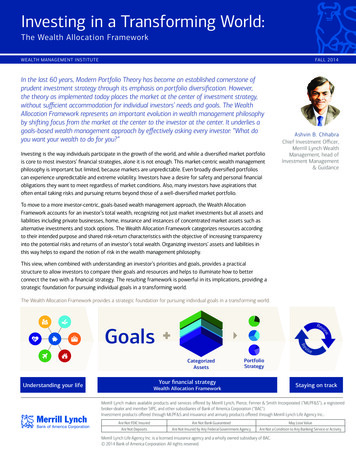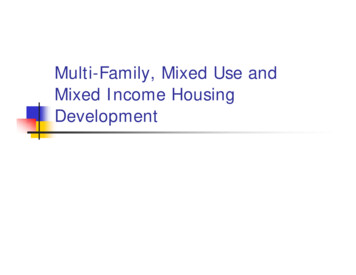
Transcription
Social &DemographicTrendsTuesday, July 26, 2011Twenty-to-OneWealth Gaps Rise to Record HighsBetween Whites, Blacks and HispanicsPaul Taylor, DirectorRakesh Kochhar, Senior ResearcherRichard Fry, Senior EconomistGabriel Velasco, Research AnalystSeth Motel, Research AssistantFOR FURTHER INFORMATION CONTACT:Pew Social & Demographic TrendsTel (202) 419-43721615 L St, N.W., Suite 700Washington, D.C. 20036www.pewsocialtrends.org
2Wealth Gaps Rise to Record Highs Between Whites, Blacks and HispanicsTable of ContentsPAGEExecutive Summary1Chapter 1: The Macroeconomic Context9Chapter 2: Household Wealth13Chapter 3: Net Worth by Type of Asset17Chapter 4: Asset Ownership22Chapter 5: Which Assets Are Most Important?24Chapter 6: The Geography of the Housing Downturn26Chapter 7: Trends in Household Wealth, 1984 to 200929Chapter 8: Wealth Gaps within Racial and Ethnic Groups32References33Appendix35Copyright 2011 Pew Research Centerwww.pewresearch.org
1Wealth Gaps Rise to Record Highs Between Whites, Blacks and HispanicsTwenty-to-OneWealth Gaps Rise to Record HighsBetween Whites, Blacks and HispanicsBy Rakesh Kochhar, Richard Fry and Paul TaylorEXECUTIVE SUMMARYThe median wealth of white households is 20times that of black households and 18 timesthat of Hispanic households, according to aPew Research Center analysis of newlyavailable government data from 2009.These lopsided wealth ratios are the largestsince the government began publishing suchdata a quarter century ago and roughly twicethe size of the ratios that had prevailedbetween these three groups for the twodecades prior to the Great Recession thatended in 2009.Median Net Worth of Households,2005 and 2009in 2009 dollars2009Whites 113,149Hispanics 6,325Blacks 5,6772005WhitesHispanics 134,992 18,359The Pew Research analysis finds that, inpercentage terms, the bursting of the housingBlacks 12,124market bubble in 2006 and the recession thatfollowed from late 2007 to mid-2009 took aSource: Pew Research Center tabulations of Survey of Incomeand Program Participation datafar greater toll on the wealth of minoritiesPEW RESEARCH CENTERthan whites. From 2005 to 2009, inflationadjusted median wealth fell by 66% amongHispanic households and 53% among black households, compared with just 16% among whitehouseholds.As a result of these declines, the typical black household had just 5,677 in wealth (assetsminus debts) in 2009; the typical Hispanic household had 6,325 in wealth; and the typicalwhite household had 113,149.
2Wealth Gaps Rise to Record Highs Between Whites, Blacks and HispanicsMoreover, about a third of black (35%) andHispanic (31%) households had zero ornegative net worth in 2009, compared with15% of white households. In 2005, thecomparable shares had been 29% for blacks,23% for Hispanics and 11% for whites.Percentage Change in Median NetWorth of Households, 2005 to 2009-16%-66%Hispanics and blacks are the nation’s twolargest minority groups, making up 16% and12% of the U.S. population respectively.-53%WhitesHispanicsBlacksSource: Pew Research Center tabulations of Survey of IncomeThese findings are based on the Pewand Program Participation dataResearch Center’s analysis of data from thePEW RESEARCH CENTERSurvey of Income and Program Participation(SIPP), an economic questionnaire distributed periodically to tens of thousands of householdsby the U.S. Census Bureau. It is considered the most comprehensive source of data abouthousehold wealth in the United States by race and ethnicity. The two most recentadministrations of SIPP that focused on household wealth were in 2005 and 2009. Data fromthe 2009 survey were only recently made available to researchers. 1Plummeting house values were the principal cause of the recent erosion in household wealthamong all groups, with Hispanics hit hardest by the meltdown in the housing market.From 2005 to 2009, the median level of home equity held by Hispanic homeowners declinedby half—from 99,983 to 49,145—while the homeownership rate among Hispanics was alsofalling, from 51% to 47%. A geographic analysis suggests the reason: A disproportionate shareof Hispanics live in California, Florida, Nevada and Arizona, which were in the vanguard of thehousing real estate market bubble of the 1990s and early 2000s but that have since beenamong the states experiencing the steepest declines in housing values.1Data on the wealth of households are also collected in the Survey of Consumer Finances (SCF) and the Panel Survey of IncomeDynamics (PSID), neither with as large a sample size as SIPP. The SCF was last conducted in 2010 and the PSID last collectedwealth data in 2009. However, the final sets of data from those surveys were not available as of the writing of this report.
3Wealth Gaps Rise to Record Highs Between Whites, Blacks and HispanicsWealth Ratios: A 25-Year HistoryThe chart to the right shows the Pew ResearchMedian Wealth Ratios, 1984 to2009Center’s estimates of the wealth ratios for 2009 and19those published by the Census Bureau for 1984 to2004. As the chart demonstrates, the white-to-blackand white-to-Hispanic wealth ratios were much higherin 2009 than they had been at any time since 1984,1210the first year for which the Census Bureau published1011107wealth estimates by race and ethnicity based on SIPPdata.Note that the ratios shown in the chart for 2009 differslightly from the 2009 estimates used in the rest of1984198819911993199520042009this report: 19-to-1 for the white-to-black ratio,compared with 20-to-1 elsewhere in the report, andWhite-to-Hispanic15-to-1 for the white-to-Hispanic ratio, compared with1518-to-1 elsewhere in the report. That is because, inorder to make the estimates in the chart consistentover time, the 2009 figures were adjusted to allow the888198419881991racial groups “white” and “black” to include Hispanic107719952004members of these groups, consistent with methodsused by the Census Bureau from 1984 to 2004. In therest of this report, the white, black (and Asian) racialgroups include only the non-Hispanic components of19932009these populations. (Changes in racial identificationmethods and a redesign of SIPP in 1996 may alsohave had an impact on the comparability of the wealthratios over time).Notes: Blacks and whites include Hispanics. The Survey ofIncome and Program Participation was redesigned for the 1996panel. The redesign may have affected the comparability ofthe data from 1998 and later years with the data from earlierpanels.Sources: For 2009: Pew Research Center tabulations of Surveyof Income and Program Participation data from the 2008panel; for 1984 to 2004: various U.S. Census Bureau P-70Current Population ReportsPEW RESEARCH CENTER
4Wealth Gaps Rise to Record Highs Between Whites, Blacks and HispanicsWhite and black homeowners also saw the median value of their home equity decline duringthis period, but not by as much as Hispanics. Among white homeowners, the decline was from 115,364 in 2005 to 95,000 in 2009. Among black homeowners, it was from 76,910 in 2005to 59,000 in 2009. There was little or no change during this period in the homeownershiprate for whites and blacks; it fell from 47% to 46% among blacks and was unchanged at 74%among whites. 2Household wealth is the accumulated sumof assets (houses, cars, savings andchecking accounts, stocks and mutualfunds, retirement accounts, etc.) minus thesum of debt (mortgages, auto loans, creditcard debt, etc.). It is different fromhousehold income, which measures theannual inflow of wages, interest, profits andother sources of earning. Wealth gapsbetween whites, blacks and Hispanics havealways been much greater than incomegaps.An Alternative Approach toMeasuring the Wealth Gap TrendThis report measures the changing wealth gapsbetween whites, Hispanics and blacks using ratios. Analternative approach would be to measure thechanges in absolute levels rather than ratios. By thatyardstick, the median wealth gaps between thesegroups decreased from 2005 to 2009. For example, in2005, the median wealth of white households was 116,632 more than the median wealth of Hispanichouseholds. By 2009, the difference had shrunk to 106,824. The same is true for the white-blackdifference in median wealth. This means that whitehouseholds experienced a greater absolute drop intheir wealth. However, because the wealth base forwhite households is so much far larger than it is forHispanics and blacks, the proportional decrease inwealth was much less for whites. That is reflected inthe sharp rise of the white-to-Hispanic and white-toblack wealth ratios reported in this study.The 2005 to 2009 time frame allows for abefore-and-after look at the impact of theGreat Recession. However, those dates donot align perfectly with the downturn, which ran from December 2007 to June 2009,according to the National Bureau of Economic Research.In 2005, both the stock and housing markets were still rising. Thus, had the base year for thesemeasurements of wealth been closer to the top of these markets in 2006 or 2007, the recordeddeclines are likely to have been even steeper.Moreover, since the official end of the recession in mid-2009, the housing market in the U.S.has remained in a slump while the stock market has recaptured much of the value it lost from2007 to 2009. Given that a much higher share of whites than blacks or Hispanics own stocks—as well as mutual funds and 401(k) or individual retirement accounts (IRAs)—the stock market2The homeownership rates cited in this report are derived from SIPP data. They differ from homeownership rates published bythe Census Bureau from other data sources.
5Wealth Gaps Rise to Record Highs Between Whites, Blacks and Hispanicsrebound since 2009 is likely to have benefited white households more than minorityhouseholds.Other key findings from the report:Hispanics: The net worth of Hispanic households decreased from 18,359 in 2005 to 6,325in 2009. The percentage drop—66%—was the largest among all groups. Hispanics derivednearly two-thirds of their net worth in 2005 from home equity and are more likely to reside inareas where the housing meltdown was concentrated. Thus, the housing downturn had a deepimpact on them. Their net worth also diminished because of a 42% rise in median levels ofdebt they carried in the form of unsecured liabilities (credit card debt, education loans, etc.).Blacks: The net worth of black households fell from 12,124 in 2005 to 5,677 in 2009, adecline of 53%. Like Hispanics, black households drew a large share (59%) of their net worthfrom home equity in 2005. Thus, the housing downturn had a strong impact on their networth. Blacks also took on more unsecured debt during the economic downturn, with themedian level rising by 27%.Whites: The drop in the wealth of white households was modest in comparison, falling 16%from 134,992 in 2005 to 113,149 in 2009. White households were also affected by thehousing crisis. But home equity accounts for relatively less of their total net worth (44% in2005), and that served to lessen the impact of the housing bust. Median levels of unsecureddebt among whites rose by 32%.Asians: In 2005 median Asian household wealth had been greater than the median for whitehouseholds, but by 2009 Asians lost their place at the top of the wealth hierarchy. Their networth fell from 168,103 in 2005 to 78,066 in 2009, a drop of 54%. Like Hispanics, they aregeographically concentrated in places such as California that were hit hard by the housingmarket meltdown. The arrival of new Asian immigrants since 2004 also contributedsignificantly to the estimated decline in the overall wealth of this racial group. Absent theimmigrants who arrived during this period, the median wealth of Asian households isestimated to have dropped 31% from 2005 to 2009. Asians account for about 5% of the U.S.population.No Assets: About a quarter of all Hispanic (24%) and black (24%) households in 2009 had noassets other than a vehicle, compared with just 6% of white households. These percentages arelittle changed from 2005.
6Wealth Gaps Rise to Record Highs Between Whites, Blacks and HispanicsMedians and Means: Just as the gap in median household wealth among racial and ethnicgroups rose from 2005 to 2009, so too did the gap in mean household wealth. However, themean differences are not as dramatic as the median differences. (A median is the midpointthat separates the upper half from the lower half of a given group; a mean is an average, and, inthis case, the average is driven upward by households with high net worth). In 2005, meanwhite household wealth was 2.3 times that of Hispanics and 3 times that of blacks. By 2009, itwas 3.7 times that of both Hispanics and blacks.Wealth Disparities within Racial and Ethnic Groups: During the period under study,wealth disparities increased not only between racial and ethnic groups, they also rose withineach group. Even though the wealthiest 10% of households within each group suffered a loss inwealth from 2005 to 2009, their share of their group’s overall wealth rose during this period.The increase was the greatest among Hispanics, with the top 10% boosting their share of allHispanic household wealth from 56% in 2005 to 72% in 2009. Among whites, the share ofwealth owned by the top 10% rose from 46% in 2005 to 51% in 2009. These trends indicatethat those in the top 10% of the wealth ladder were relatively less impacted by the economicdownturn than those in the remaining 90%.
7Wealth Gaps Rise to Record Highs Between Whites, Blacks and HispanicsTerminologyReferences to whites, blacksand Asians are to the nonHispanic components ofthose populations. The onlyexception to this rule iswhen historical comparisonsare drawn with datapublished by the CensusBureau.“Asian” refers to (nonHispanic) persons reportingtheir racial origin as Asianalone and does not includenative Hawaiians or otherPacific Islanders. “Black”refers to black alone, and“white” refers to white alone.The racial and ethnicidentity of a household isdetermined on the basis ofthe racial and ethnic identityof the head of the household.Household “net worth” is thesum of the market value ofassets owned by everymember of the householdminus their liabilities (debt).Unless otherwise stated, allestimates in this report areexpressed in 2009 dollars.SIPP Net WorthSIPP data include the following assets and liabilities:Assets Financial institution accountsoSavings accountsoMoney market deposit accountsoCertificates of deposit (CD)oInterest-earning checking accountsoRegular checking accounts Other interest-earnings assetsoU.S. government securitiesoMunicipal or corporate bondsoU.S. savings bonds Stocks and mutual fund shares Business or profession Motor vehicles Owned home Rental property Vacation homes and other real estate IRA and Keogh accounts 401(k) and Thrift Saving Plans Mortgages held for sale of real estate Amount due from sale of business or property Other financial assetsLiabilities Secured liabilitiesoMargin and broker accountsoDebt on business or professionoVehicle loansoMortgages on own homeoMortgages on rental propertyoMortgages on other homes or real estateUnsecured liabilitiesoCredit card and store billsoStudent loansoDoctor, dentist, hospital, and nursing home billsoLoans from individualsoLoans from financial institutionsoOther unsecured liabilitiesMajor assets not captured by SIPP are equities in defined-benefit pensionplans, the cash value of life insurance policies, the value of householdfurnishings and jewelry, and future claims on Social Security. Thus,wealth estimates from SIPP are typically less than the estimates from theSurvey of Consumer Finances.
8Wealth Gaps Rise to Record Highs Between Whites, Blacks and HispanicsAbout the ReportThis report presents net worth and asset ownership figures from wave 6 of the 2004 panel ofthe Survey of Income Program and Participation (SIPP) and wave 4 of the 2008 SIPP panel.These waves were conducted at the end of 2005 and 2009, respectively. SIPP is a longitudinalsurvey of households conducted by the U.S. Census Bureau. By design, SIPP oversamples lowincome households and thus surveys large numbers of minority households. SIPP hasperiodically collected detailed wealth data since 1984 and is considered an authoritative sourceon the wealth of American households. As with any survey, estimates from SIPP are subject tosampling and nonsampling errors. See the appendix for more details.This report was edited and the overview written by Paul Taylor, executive vice president of thePew Research Center and director of its Social and Demographic Trends project. Seniorresearcher Rakesh Kochhar and senior economist Richard Fry researched and wrote thereport. Research assistant Seth Motel helped with the preparation of charts. The report wasnumber-checked by Motel and Pew Research Center staff member Gabriel Velasco. The reportwas copy-edited by Marcia Kramer. The Center is grateful for the expeditious assistance ofNasrin Dalirazar of the Housing and Household Economic Statistics Division of the U.S.Census Bureau on the definition of SIPP net worth components, weighting issues, and thereplication of wealth tabulations published by the Census Bureau.
9Wealth Gaps Rise to Record Highs Between Whites, Blacks and HispanicsCHAPTER 1: THE MACROECONOMIC CONTEXTThe period of 2005 to 2009 was marked by a series of tumultuous economic developments. Abubble in the housing market burst in 2006, triggering the Great Recession in 2007 and astock market collapse in 2007-2008. Each of these events was historic in its magnitude, and itis not surprising that household wealth would shrink under their collective weight. Thissection of the report provides background on the major economic trends that created thecontext for the sharp erosion of household wealth from 2005 to 2009. 3The Housing MarketThe sharp increase inhousing prices thatcharacterized the real estatebubble can be traced to themiddle of the 1990s. At thetime, the U.S. economy wasin the midst of the longesteconomic expansion onrecord, from March 1991 toMarch 2001. After remainingflat for the first half of the1990s, home prices, asmeasured by the S&P/CaseShiller Index, rose 29% fromthe first quarter of 1995 tothe first quarter of 2000.S&P/Case-Shiller Index of Home Prices, 1990 to20101990, First Quarter 1003002502502001501731711005001990 1992 1994 1996 1998 2000 2002 2004 2006 2008 2010Note: The S&P/Case-Shiller Index is the quarterly, seasonally adjusted nationalFor housing prices, the lattercomposite index of home prices.Source: Downloaded on March 24, 2011, fromhalf of the 1990s ve to be only the prelude.PEW RESEARCH CENTERIn the space of the next sixyears home prices nearlydoubled, increasing 89% from the first quarter of 2000 to the first quarter of 2006. However,3For a more detailed analysis of economic trends in the recession, see Pew Research Center, Social and Demographic Trends(2010), t-recession-has-changed-life-in-america/; and Pew ResearchCenter, Social and Demographic Trends (2011), ome-still/.
10Wealth Gaps Rise to Record Highs Between Whites, Blacks and Hispanicsthe clock then rewound quickly. By the first quarter of 2009, home prices had fallen 31%. Andsince then, they have remained flat.The 2006 peak in home prices and the subsequent trough in 2009 roughly coincide with thedates of the wealth estimates reported in this study. In particular, the 2005 wealth data werecollected from September to December 2005, and the 2009 wealth data were collected fromAugust to November 2009 (see the appendix for details). Thus, the wealth estimates in thisreport, and the estimated changes from 2005 to 2009, capture the brunt of the housingdownturn.The rise of the housing bubble and its deflation were not evenly distributed across the countryor across demographic groups. The run-up in home prices was among the steepest inCalifornia, Arizona, Nevada and Florida, and so was the run-down. For example, according tothe S&P/Case-Shiller Index, home prices rose 168% in the Miami metropolitan area fromJanuary 2000 to January 2006. But they fell 45% from January 2006 to December 2009.Some other states, such as Michigan, have suffered sharp losses in house prices since 2006even though they did not experience much of a run-up during the bubble years. (In the case ofMichigan, the main culprit has been job losses caused by the manufacturing downturn.)Another facet of the housing meltdown is the rise in foreclosure rates. According toRealtyTrac , the number of homes in the U.S. with at least one foreclosure filing increasedfrom 0.6% in 2006 to 2.2% in 2010. The rates were much higher in some states: Nevada(9.4%); Arizona (5.7%); Florida (5.5%); and California (4.1%). Research also suggests thatHispanics and blacks were twice as likely as whites to experience foreclosures from 2007 to2009. 4The growth in home prices was accompanied by a historic increase in the homeownership rate.From 1994 to 2004, the U.S. homeownership rate increased from 64% to 69%. A rise of thismagnitude in the course of a decade was last seen in the post-World War II economic boom.Minorities, especially Asians, rode the crest of this wave, narrowing the gap in homeownershipwith respect to whites. However, homeownership rates peaked in 2004 for whites and blacksand in 2006 for Hispanics and Asians. 5 Since then, homeownership rates have been flat ordeclining for all groups, adding to the downward pressure on household wealth.45See Bocian, Li and Ernst (2010).See Kochhar, Gonzalez-Barrera and Dockterman (2009), http://pewhispanic.org/reports/report.php?ReportID 109.
11Wealth Gaps Rise to Record Highs Between Whites, Blacks and HispanicsThe Stock MarketHouseholds seeking to recoup real estate losses in the stock market would have met withdisappointment. Stock prices fell sharply twice within the past decade. The first episode lastedfrom 2000 to 2002, surrounding the 2001 recession. The S&P 500 index dropped from a highof 1,518 in August 2000 to 815in September 2002, a fall ofS&P 500 Index, 1990 to 201046%.1800The second episode ofplunging stock prices wasfueled by the subprimelending crises and, notcoincidentally, mostly ranparallel to the housingdownturn. This time, the S&P500 index fell from 1,549 inOctober 2007 to 735 inFebruary 2009, a drop of 53%.The stock market hasrecovered since then and theS&P 500 had reached 1,115 byDecember 2009, the last datefor which wealth data arereported in this 0020001990 1992 1994 1996 1998 2000 2002 2004 2006 2008 2010Note: The S&P 500 data are the index levels at closing on the final day of aquarter.Source: Downloaded on April 5, 2011, from http://finance.yahoo.com/PEW RESEARCH CENTERAs noted earlier, the wealthestimates in this study are for the end of 2005 and the end of 2009. This period includes boththe increase in stock prices from 2005 to 2007 and the subsequent decline through 2009.Overall, the S&P 500 fell from 1,248 in December 2005 to 1,115 in December 2009, a loss of11%.
12Wealth Gaps Rise to Record Highs Between Whites, Blacks and HispanicsThe Labor MarketThe Great Recession lasted from December 2007 to June 2009 and was historic by most labormarket indicators. The most visible labor market effect of the recession was the loss of 7.5million jobs during its official duration. At the same time, the unemployment rate rose from5.0% in December 2007 to 9.5% in June 2009.Perhaps the most striking feature of the Great Recession is that those without jobs areenduring the longest spells of unemployment recorded in the post-WWII era. At the start ofthe recession, in December 2007, the median duration of unemployment was 8.4 weeks. ByJune 2009, the median duration had risen to 17.4 weeks. It continued to rise beyond the end ofthe recession and peaked at 25.5 weeks in June 2010.The rise in long-term unemployment is significant. There is considerable evidence of negativeconsequences associated with unemployment—loss in income, career interruptions, ill effectson families and health. Moreover, long-term unemployment can feed upon itself. That isbecause the likelihood of reemployment falls the longer a person has been out of work. 6One feature of economic downturns is that minorities tend to experience greater increases inunemployment. The Great Recession is no exception. Job losses were higher for Hispanic andblack workers than for whites. The Hispanic unemployment rate (nonseasonally adjusted)increased from 5.9% in the fourth quarter of 2007 to 12.6% in the fourth quarter of 2009. Theblack unemployment rate increased from 8.6% to 15.6%. The increase in the unemploymentrate for whites was much less, from 3.7% to 8.0%.A related consequence of the recession was a decline in household income. In inflationadjusted dollars, the median income of white households fell 4%, from 56,814 in 2007 to 54,461 in 2009. The loss in income was greater for minority households. Median householdincome for Hispanics decreased 5% and the income of black households dropped 7%. 7The negative consequences of the Great Recession—lost jobs, record long spells ofunemployment and dwindling incomes—are likely to have had an impact on household networth above and beyond the direct effect of falling asset prices.6For example, see von Wachter and Sullivan (2009); Elsby, Hobijn and Sahin (2010); and Pew Research Center, Social andDemographic Trends (2010), t-recession-has-changed-life-in-america/.7See DeNavas-Walt, Proctor and Smith (2010). In Census Bureau data on household income, black households include Hispanics.
13Wealth Gaps Rise to Record Highs Between Whites, Blacks and HispanicsCHAPTER 2: HOUSEHOLD WEALTHAdjusted for inflation, 8 the median wealth, or net worth, of U.S. households fell from 96,894in 2005 to 70,000 in 2009, a drop of 28%. The precipitous decline in wealth was not evenlydistributed across groups. Minority households—Hispanics, blacks and Asians—experiencedfar steeper declines than white households.Minority households experienced greater losses because they are more dependent on homeequity as a source of wealth. As noted above, housing values started to fall sooner than stockprices and, unlike the stock market, the housing market has not begun to recover. Hispanicsand Asians were further affected because they are disproportionately likely to reside in statesthat have been among the hardest hit by the housing crisis: California, Florida, Nevada andArizona. Hispanics and blacks have also been more susceptible to home foreclosures and theirhomeownership rates have dropped more than for any other group.Household Wealth by Race and EthnicityIn 2009, the median networth of white households— 113,149—was the highest ofall groups. In sharp contrast,Hispanic and blackhouseholds had median networth of 6,325 and 5,677respectively. Asianhouseholds, with a mediannet worth of 78,066, hadmuch more wealth in 2009than Hispanics and blacksbut much less than whites.All groups experienced dropsin wealth from 2005 to 2009but there were sharpdifferences among them.8Median Net Worth of Households, 2005 and2009in 2009 dollars20052009 168,103 134,992 113,149 78,066 18,359 6,325WhitesHispanics 12,124 5,677BlacksAsiansSource: Pew Research Center tabulations of Survey of Income and ProgramParticipation data from the 2004 and 2008 panelsPEW RESEARCH CENTERUnless otherwise stated, all data in this report are expressed in 2009 dollars.
14Wealth Gaps Rise to Record Highs Between Whites, Blacks and HispanicsHispanics’ median net worth fell 66%, from 18,359 in 2005 to 6,325 in 2009. Blackhouseholds experienced a loss of 53%, from 12,124 in 2005 to 5,677 in 2009. The drop inthe wealth of white households was modest in comparison, falling 16% from 134,992 in 2005to 113,149 in 2009.Asian households lost their standing at the top of the wealth ranking. Their net worth isestimated to have fallen by 54%, from 168,103 in 2005 to 78,066 in 2009.However, as discussed in greater detail in the appendix, the recorded decrease in the wealth ofAsian households, more than three-quarters of which are headed by immigrants, is sensitive tothe arrival of new immigrants between 2005 and 2009. The accumulation of assets takes time,and immigrants initially tend to have low levels of wealth. 9 If the 2009 SIPP sample is adjustedto remove immigrants who arrived since 2004, the median wealth of Asian households in 2009is estimated to be 116,555. That is a drop of 31% from 2005, nearly twice as much as for whitehouseholds but still leaving Asian households with median wealth that is similar to that ofwhites. 10The Gap in Wealth between Whites, Hispanics and BlacksIn 2009, the median wealth of white households was 20 times as high as the wealth of blackhouseholds and 18 times as much as the wealth of Hispanic households. These ratios are abouttwice as high as the ratios that existed before the onset of the housing crisis, the stock marketcrash and the Great Recession. In 2005, the median wealth of white households was 11 timesthe wealth of black households and seven times the wealth of Hispanic households. The wealthgaps that currently exist between whites, Hispanics and blacks are the highest in at least 25years. 119See Kochhar (2004), http://pewhispanic.org/reports/report.php?ReportID 34.Removing newly arrived immigrants from the 2008 SIPP panel does not have a notable effect on estimates for white, black andHispanic households. In brief, the wealth estimates for 2005 and 2009 are based on panels of households formed in 2004 and2008, respectively. As such, the 2005 estimates are representative of the U.S. household population in February 2004 and the2009 estimates are representative of households in September 2008. I
2005, the median wealth of white households was 116,632 more than the median wealth of Hispanic households. By 2009, the difference had shrunk to 106,824. The same is true for the white-black difference in median wealth. This means that white households experienced a greater absolute drop in their wealth. However, because the wealth base for










